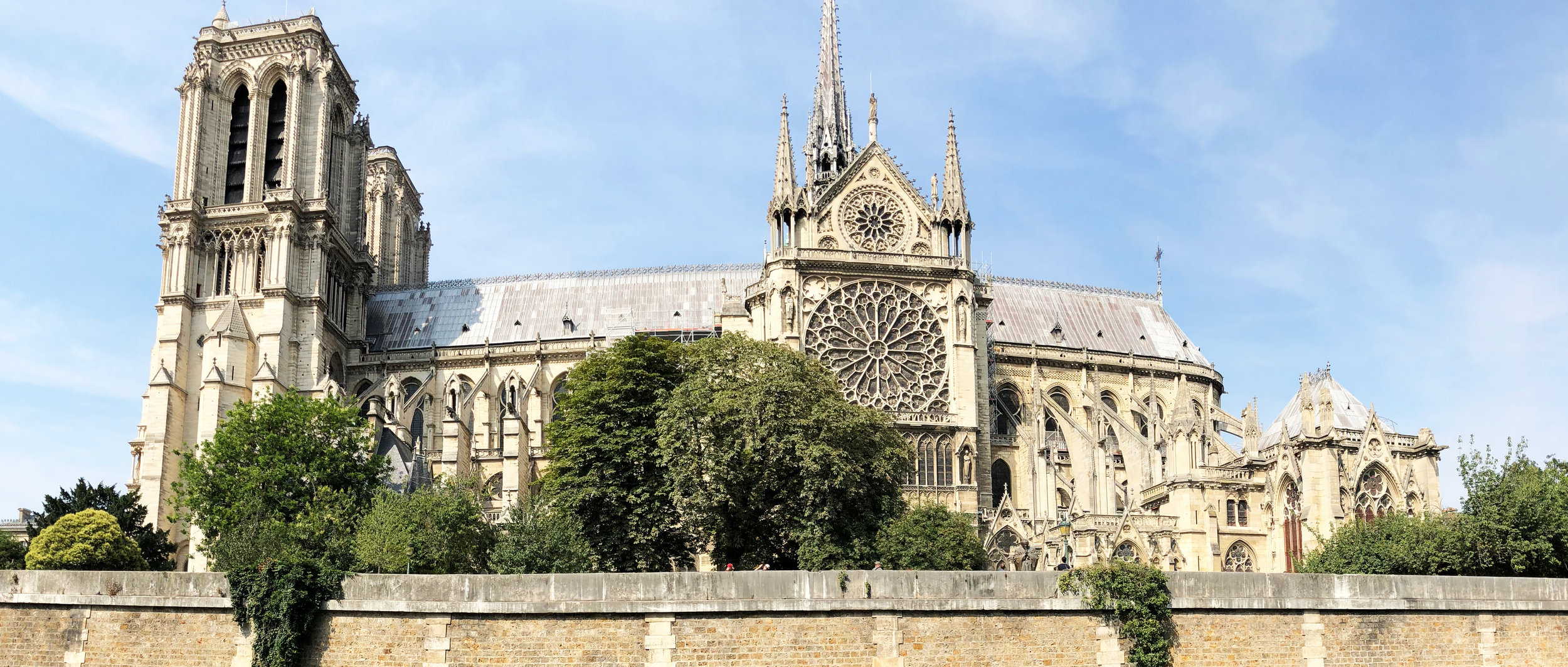The day I visited the Cathedral of Notre Dame, early on a spring morning in 1998, there was (oddly) almost nobody there. There wasn’t even a line to get in the front. Walking over the courtyard to the imposing tri-yawn of the front entrance, I swore (forgetting where I was) as I’d planned a solid walking tour of Paris, and already, my meticulous itinerary seemed for not since its crowning commencement was inexplicably closed.
But then, at the entrance, a nice man with white gloves welcomed me inside (this was before the metal detectors) and, for an incredible moment, it seemed I had the entire cathedral to myself which, when you’re traveling, is both a blessing and a curse.
My first, tentative steps inside brought a heavy waft of wet masonry and faraway incense. I held myself from the crisp air (inside was much cooler than outside) so that I must have looked like a shivering idiot in my shorts and t-shirt.
I had just finished reading Ken Follet’s The Pillars of the Earth and I considered myself an expert on cathedrals, their construction, and their grim and brutal histories. I had learned, for example, that Notre Dame is not even that big. As cathedrals go, it is considered a middleweight. I also learned how every feature of a cathedral belonged to a correlating provocation. From the imposing, humbling entrance, to the walls and vaulted ceilings, which almost force visitors to look heavenward. Armed with this knowledge, I had prepared myself, as an anthropologist would prepare for a kegger, for an entirely cynical and un-magical examination of Notre Dame with my collection of trivial tidbits at the ready, should even the most remote opportunity to bloviate on the finer esoterica of cathedraldom present itself. (I was lonely)
Thank God, I was never given the opportunity. Stepping into the main corridor, I forgot myself almost immediately (also part of the design, but okay). I was shocked at its immensity—what looked obviously large from the outside, from the inside seemed twice as big, maybe bigger. Maybe a small aircraft could fly around in there, without bothering any of the saints. The ribbed walls (roman or gothic, who knows?) were shot-through with morning light, and sent pillars of candied sun streaming this way and that.
It’s a prism! I remember thinking, pleasantly surprised that, in spite of everything (and catholicism has much everything), Notre Dame was a huge prism. How delightful. Notre Dame was also an echo chamber, apparently. A rambunctious group of 20-30 senior American tourists had just poured in from outside, shouting and jostling each other like it was D-Day. Their bombastic echos shook the halls with compounding resonance.
Finally, a tour guide gathered the rambunctious Americans to begin their English tour of the cathedral. Seeing this, I figured it wouldn’t harm if I just hung back from the crowd, and listened in. This was an excellent plan, and all was going well, until the tour guide, describing the three entrances to the cathedral, spent an extra long time describing the Northernmost of the three front doors: the Portal of the Virgin. With her heavy accent, the guide described the figurines crowning “Mary’s Hole,” how they illustrated Mary’s death, her ascent to paradise and finally, her coronation as the Queen of Heaven. Occasionally, the guide swapped “hole” for “portal,” which was way worse. My laughter was conspicuous enough the guide paused her lecture, “Excuse me!” she hissed. “Zere is nussing funny about Mary’s Portal!”
At this, the poor guide’s group fell apart with laughter. They were dying!
“C’est quoi?” she said, bewildered. “What did I say?”
This is how I became dear old friends with 20 or 30 seniors from Green Bay Wisconsin in the cathedral of Notre Dame. They had all left their kids and grandchildren back home and, on this seven-day guided trip through France, seemed to have discovered a second lease on life. As we walked from one attraction to the next, I learned from a couple (whose names were actually Pearl and Marty) that it was their last day of the tour.
Pearl said with a shiver, “We fly home tomorrow.”
“Not so fast, Pearl.” said someone behind me. “It’s only morning yet, and after this tour, we’re going to get drunk on red wine.”
“Oh yeah,” said Pearl, looking up at the stained glass walls. “You should come!”
That is when I knew—I had found my people.
And then, this happened: at the end of their tour of Notre Dame, it was decided the group would take a group picture. It was the perfect moment, seeing as how it had been such a big week for everyone, and the group was moments away from to scattering to the nearest wine bars. Seeing as how I had stowed away on their guided tour, I was chosen to be the lucky photographer for this rowdy moment in history.
I was handed eight or nine cameras (all film) and given brief tutorials on how to use each one. The group huddled together, and I backed away. When I had them all in frame, I looked up from the camera and said, “Say cheese.”
A man from the group stepped forward, “No! No! No!” His voice boomed up and down the hallowed halls and sent ripples through the holy water. “This is France!” he said, pointing at the floor. “Here, they say fro-mah-gee!”
“No—” I said feebly.
“Okay everybody. On three!”
“No, it’s—”
“One.”
“Sir!?”
“Twoooo,”
“Shit.”
Cowering behind the cameras, I took a deep breath and held on tight.
On three, as threatened, in unison, some 20 or 30 seniors on rumspringa from Green Bay Wisconsin let out a battle cry that shook western Europe to the core. Notre Dame’s largest bell, the great Bourdon Emmanuel would never stop ringing.
